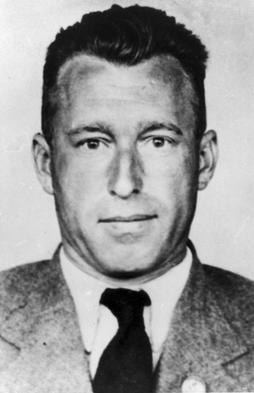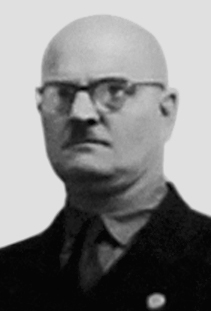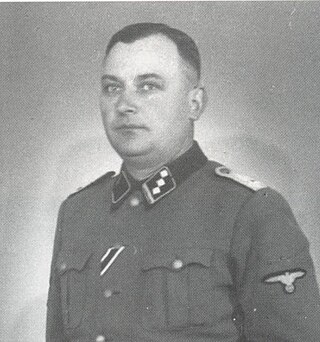Euthanasia is the practise of intentionally ending life to eliminate pain and suffering.

Karl Brandt was a German physician and Schutzstaffel (SS) officer in Nazi Germany. Trained in surgery, Brandt joined the Nazi Party in 1932 and became Adolf Hitler's escort doctor in August 1934. A member of Hitler's inner circle at the Berghof, he was selected by Philipp Bouhler, the head of Hitler's Chancellery, to administer the Aktion T4 euthanasia program. Brandt was later appointed the Reich Commissioner of Sanitation and Health. Accused of involvement in human experimentation and other war crimes, Brandt was indicted in late 1946 and faced trial before a U.S. military tribunal along with 22 others in United States of America v. Karl Brandt, et al. He was convicted, sentenced to death, and hanged on 2 June 1948.

Aktion T4 was a campaign of mass murder by involuntary euthanasia in Nazi Germany. The term was first used in post-war trials against doctors who had been involved in the killings. The name T4 is an abbreviation of Tiergartenstraße 4, a street address of the Chancellery department set up in early 1940, in the Berlin borough of Tiergarten, which recruited and paid personnel associated with Aktion T4. Certain German physicians were authorised to select patients "deemed incurably sick, after most critical medical examination" and then administer to them a "mercy death". In October 1939, Adolf Hitler signed a "euthanasia note", backdated to 1 September 1939, which authorised his physician Karl Brandt and Reichsleiter Philipp Bouhler to begin the killing.

Herbert Lange was a German SS functionary during the Nazi era. He was commandant of Chełmno extermination camp until April 1942, as well as leader of the SS Special Detachment Lange conducting the murder of Jews from the Łódź Ghetto. Lange was responsible for numerous crimes against humanity, including the murder of mentally disabled patients in Poland and in Germany during the Aktion T4 "euthanasia" programme, and became one of the key originators of the Holocaust.

Franz Paul Stangl was an Austrian police officer and commandant of the Nazi extermination camps Sobibor and Treblinka in World War II.

Christian Wirth was a German SS officer and leading Holocaust perpetrator who was one of the primary architects of the program to exterminate the Jewish people of Poland, known as Operation Reinhard. His nicknames included Christian the Cruel, Stuka, and The Wild Christian due to the extremity of his behaviour among the SS and Trawniki guards and to the camp inmates and victims.

Philipp Bouhler was a German senior Nazi Party functionary who was both a Reichsleiter and Chief of the Chancellery of the Führer of the NSDAP. He was also the SS official responsible for the Aktion T4 euthanasia program that killed more than 250,000 disabled adults and children in Nazi Germany, as well as co-initiator of Aktion 14f13, also called Sonderbehandlung, that killed 15,000–20,000 concentration camp prisoners.

Nazi eugenics refers to the social policies of eugenics in Nazi Germany, composed of various ideas about genetics. The racial ideology of Nazism placed the biological improvement of the German people by selective breeding of "Nordic" or "Aryan" traits at its center. These policies were used to justify the involuntary sterilization and mass-murder of those deemed "undesirable".

Heinrich Barbl was an Austrian-born SS-Rottenführer. He participated in the T-4 euthanasia program in Nazi Germany and, after the invasion of Poland, in Operation Reinhard phase of the Holocaust.

Richard Thomalla was a German war criminal and SS commander of Nazi Germany. A civil engineer by profession, he was head of the SS Central Building Administration at Lublin reservation in occupied Poland. Thomalla was in charge of construction for the Operation Reinhard death camps Bełżec, Sobibor and Treblinka during the Holocaust in Poland.

Ernst Zierke was a low-ranking member in the SS who took part in the Action T4 forced euthanasia program in Nazi Germany, and after the invasion of Poland worked at Bełżec and Sobibór extermination camps during Operation Reinhard. Zierke helped to perpetrate the Holocaust. He was charged with being an accessory to the murder of 360,000 Jews at death camps, acquitted twice, in the Belzec and Sobibór trials of 1965 on grounds of acting under duress and set free.
Involuntary euthanasia, typically regarded as a type of murder, occurs when euthanasia is performed on a person who would be able to provide informed consent, but does not, either because they do not want to die, or because they were not asked.

Franz Karl Reichleitner was an Austrian member in the SS of Nazi Germany who participated in Operation Reinhard during the Holocaust. Reichleitner served as the second and last commandant of Sobibór extermination camp from 1 September 1942 until the camp's closure on or about 17 October 1943. As the commanding officer of the camp, Franz Reichleitner directly perpetrated the genocide of Jews.

Gottlieb Hering was an SS commander of Nazi Germany. He served in Action T4 and later as the second and last commandant of Bełżec extermination camp during Operation Reinhard. Hering directly perpetrated the genocide of Jews and other peoples during The Holocaust.

The Hartheim killing centre was a killing facility involved in the Nazi programme known as Aktion T4, in which German citizens deemed mentally or physically unfit were systematically murdered with poison gas. Often, these patients were transferred from other killing facilities such as the Am Spiegelgrund clinic in Vienna. This was initially a programme of "involuntary euthanasia" permitted under the law ostensibly to enable the lawful and painless killing of incurably ill patients; these murders continued even after the law was rescinded in 1942. Other victims included Jews, Communists and those considered undesirable by the state. Concentration camp inmates who were unfit for work, or otherwise deemed troublesome, were also executed here. The facility was housed in Hartheim Castle in the municipality of Alkoven, near Linz, Austria, which now is a memorial site and documentation centre.

The Brandenburg Euthanasia Centre, officially known as the Brandenburg an der Havel State Welfare Institute, was a killing centre established in 1939 as part of the Nazi euthanasia programme, known after the war as "Aktion T4". Nearly 10,000 people were murdered there during its operation, primarily those with mental and physical disabilities.

The Nazi Euthanasia Centre at Bernburg operated from 21 November 1940 to 30 July 1943 in a separate wing of the State Sanatorium and Mental Hospital in Bernburg on the River Saale in the German state of Saxony-Anhalt. It was one of several euthanasia centres run by the Nazis under their official "Euthanasia Programme", later referred to after the war as Action T4. A total of 9,384 sick and handicapped people from 33 welfare institutions and nursing homes as well as around 5,000 prisoners from six concentration camps were killed there in a gas chamber using carbon monoxide gas.
Child Euthanasia was the name given to the organized killing of severely mentally and physically disabled children and young people up to 16 years old during the Nazi era in over 30 so-called special children's wards. At least 5,000 children were victims of the program, which was a precursor to the subsequent murder of children in the concentration camps.

Franz Suchomel was a Sudeten German Nazi war criminal. He participated in the Action T4 euthanasia program, in Operation Reinhard, and the Einsatzgruppen actions in the Adriatic operational zone. He was convicted at the Treblinka trials in September 1965 and spent four years in prison.

The Memorial and Information Point for the Victims of National Socialist Euthanasia Killings is a memorial in Berlin, Germany to the victims of Nazi Germany's state-sponsored involuntarily euthanasia program. Over 70,000 people were murdered between 1940–41 under official order of Aktion T4. Despite the program's technical cessation in August 1941, the killings continued in state-run institutions and care facilities until Germany's surrender in 1945. This amounted to a death toll of approximately 300,000.
















